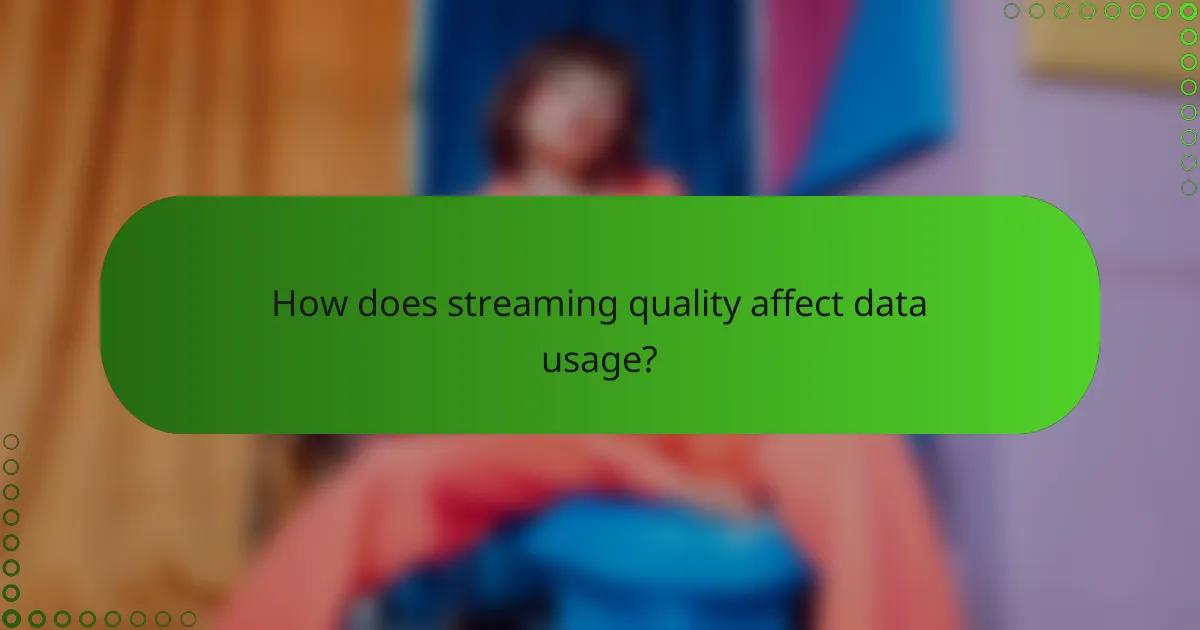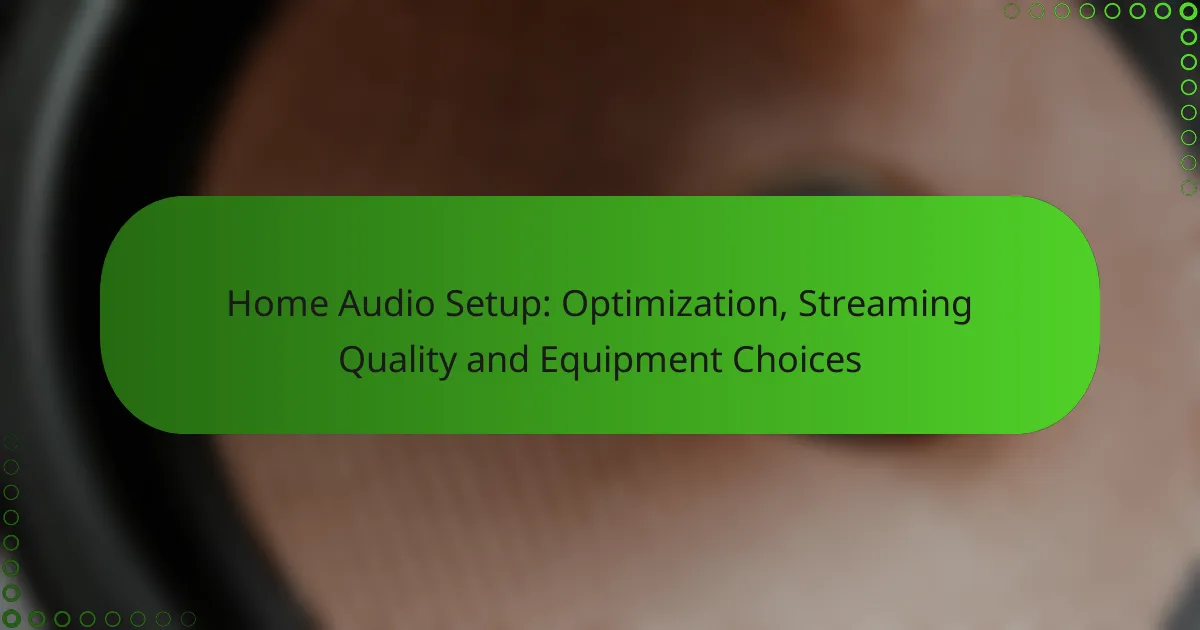Streaming quality plays a crucial role in determining data usage and overall user experience. Higher resolutions, such as 1080p or 4K, offer superior visuals but demand more bandwidth, making it essential for users to assess their data limits and internet capabilities. By optimizing their settings and ensuring a stable connection, viewers can enjoy enhanced video quality while managing their data consumption effectively.

How does streaming quality affect data usage?
Streaming quality significantly impacts data usage, with higher resolutions consuming more bandwidth. Users should consider their data limits and streaming preferences to optimize their experience without exceeding caps.
High-definition streaming increases data consumption
High-definition (HD) streaming, typically at 720p or 1080p, can use around 3 to 6 GB of data per hour. This increased consumption is due to the larger file sizes required for higher resolution video, which provides better clarity and detail.
For users with limited data plans, streaming in HD can quickly lead to exceeding monthly limits. It’s advisable to monitor data usage closely or switch to lower resolutions when nearing caps.
Standard-definition streaming uses less data
Standard-definition (SD) streaming generally consumes about 1 to 2 GB of data per hour. This lower data usage makes it a more viable option for users with strict data caps or slower internet connections.
Choosing SD can help maintain a stable streaming experience without interruptions, especially in areas with inconsistent bandwidth. Users can enjoy content without worrying as much about data overages.
Data caps impact streaming choices
Many internet service providers impose data caps, which can limit the amount of data a user can consume each month. Exceeding these caps often results in additional charges or throttled speeds, affecting streaming quality.
To avoid unexpected costs, users should evaluate their streaming habits and select plans that align with their data needs. Utilizing lower quality settings or downloading content for offline viewing can help manage data usage effectively.

What are the best streaming quality settings?
The best streaming quality settings depend on your internet bandwidth and device capabilities. Generally, higher quality settings like 1080p or 4K provide better visuals but require more data, while lower settings conserve bandwidth and are suitable for slower connections.
Auto settings adjust based on bandwidth
Auto settings automatically optimize streaming quality based on your current internet speed. This means if your bandwidth fluctuates, the streaming service will adjust the resolution to maintain a smooth viewing experience without buffering.
For instance, if you have a stable connection, the service may stream in 1080p or higher. However, if your bandwidth drops, it might switch to 720p or lower to prevent interruptions. This feature is particularly useful for users with variable internet speeds.
Manual settings allow for user control
Manual settings give users the option to select their preferred streaming quality regardless of bandwidth. This can be beneficial if you want to prioritize video quality or save data by choosing a lower resolution.
For example, if you’re on a limited data plan, you might choose to stream in 480p to conserve bandwidth. Conversely, if you have a fast connection and want the best experience, you can manually set it to 4K. Just be aware that higher resolutions will consume significantly more data, often exceeding several gigabytes per hour.

How can users optimize their streaming experience?
Users can optimize their streaming experience by ensuring a stable internet connection, minimizing background data usage, and considering higher-speed internet plans. These steps can significantly enhance video quality and reduce buffering, leading to a more enjoyable viewing experience.
Use wired connections for stability
Using wired connections, such as Ethernet cables, can greatly improve streaming stability compared to Wi-Fi. Wired connections typically offer lower latency and higher speeds, which are crucial for high-definition streaming.
For optimal results, connect your streaming device directly to the router with an Ethernet cable. This setup minimizes interference from other devices and environmental factors that can disrupt Wi-Fi signals.
Reduce background data usage
Reducing background data usage can free up bandwidth for streaming, enhancing overall quality. Close unnecessary applications and devices that may be using the internet simultaneously.
Consider adjusting settings on devices to limit automatic updates or background syncing while streaming. This can help maintain a smoother experience, especially during peak usage times.
Upgrade internet plans for higher speeds
Upgrading to a higher-speed internet plan can significantly improve streaming quality, especially for households with multiple users. Plans offering speeds of at least 25 Mbps are generally recommended for standard streaming, while 50 Mbps or more is ideal for 4K content.
Before upgrading, assess your current usage and the number of devices connected. Compare different providers and plans to find the best fit for your streaming needs and budget, ensuring you get the most value for your investment.

What are the data usage limits for popular streaming services?
Data usage limits for popular streaming services vary significantly based on the platform and the quality of the video. Understanding these limits can help users manage their data plans effectively while enjoying their favorite shows and movies.
Netflix data usage per hour
Netflix’s data usage can range from about 0.3 GB per hour for standard definition (SD) to approximately 7 GB per hour for ultra-high definition (UHD). Users should consider their viewing habits and data caps when selecting video quality to avoid exceeding their limits.
For those on limited data plans, streaming in SD or 720p can be a practical choice, as it balances quality and data consumption. Netflix also offers a “low” data-saving mode that can further reduce usage.
Amazon Prime Video data consumption
Amazon Prime Video typically consumes between 0.5 GB per hour for SD and up to 6 GB per hour for UHD content. The platform allows users to adjust their streaming quality, which can help manage data usage effectively.
To optimize data consumption, consider downloading content for offline viewing when connected to Wi-Fi. This can significantly reduce data usage during streaming sessions.
Disney+ streaming data requirements
Disney+ data usage generally ranges from 0.5 GB per hour for SD to around 7 GB per hour for 4K streaming. The service provides options to adjust video quality based on user preferences and data availability.
For users with limited data plans, streaming in lower resolutions or downloading shows and movies while on Wi-Fi can help avoid unexpected charges. Regularly monitoring data usage through your device settings can also be beneficial.

What factors influence streaming plan considerations?
Several factors influence streaming plan considerations, including internet speed, device compatibility, and monthly data caps. Understanding these elements helps users choose the right plan for a seamless streaming experience.
Internet speed requirements
Internet speed is crucial for streaming quality, as it determines how smoothly content plays. Generally, a minimum speed of 3 Mbps is recommended for standard definition, while high definition requires at least 5-10 Mbps, and 4K streaming can demand 25 Mbps or more.
When selecting a streaming plan, consider your household’s total internet usage. If multiple devices are streaming simultaneously, you may need to increase your speed to avoid buffering and interruptions.
Device compatibility
Device compatibility is essential for accessing streaming services effectively. Most platforms support popular devices like smart TVs, tablets, smartphones, and gaming consoles, but it’s important to check if your specific device is compatible with the service you choose.
Additionally, some streaming services offer exclusive content or features that may only be available on certain devices. Always verify compatibility before committing to a plan to ensure a smooth viewing experience.
Monthly data caps
Monthly data caps can significantly impact your streaming experience, especially if your internet service provider (ISP) imposes limits on data usage. Exceeding these caps may result in throttled speeds or additional charges, which can disrupt your streaming activities.
To avoid issues, review your ISP’s data policies and estimate your monthly usage based on your streaming habits. For example, streaming in HD can consume about 3 GB per hour, while 4K streaming can use up to 7 GB per hour. Adjust your plan accordingly to ensure you stay within limits.

How do different resolutions impact streaming quality?
Different resolutions significantly affect streaming quality by determining the clarity of the video and the amount of data used. Higher resolutions provide better visual experiences but require more bandwidth, while lower resolutions can accommodate slower internet connections but may sacrifice image quality.
4K streaming requires more bandwidth
4K streaming offers exceptional detail and clarity, making it ideal for large screens. However, it typically requires a stable internet connection with speeds of at least 25 Mbps to function smoothly. Users should ensure their internet plan supports this bandwidth to avoid buffering and interruptions.
For those considering 4K streaming, it’s essential to check if their devices and subscriptions support this resolution. Streaming services may also have specific requirements or recommendations for optimal performance.
1080p offers a balance of quality and data
1080p resolution strikes a good balance between video quality and data usage, making it a popular choice for many viewers. It generally requires about 5 to 10 Mbps for smooth playback, which is manageable for most modern internet connections.
This resolution is suitable for a wide range of devices and can provide a satisfying viewing experience without overwhelming bandwidth limitations. Users can enjoy high-definition content without the need for the fastest internet speeds.
720p is suitable for slower connections
720p resolution is a practical option for users with slower internet connections, requiring only about 3 to 5 Mbps. While it does not offer the same level of detail as higher resolutions, it still delivers a decent viewing experience for smaller screens or casual viewing.
Choosing 720p can help prevent buffering issues and allow for smoother playback, especially in areas with limited internet infrastructure. It’s a good compromise for those who prioritize stability over visual fidelity.

What are the emerging trends in streaming technology?
Emerging trends in streaming technology focus on enhancing user experience, optimizing data usage, and adapting to diverse internet environments. Innovations such as adaptive bitrate streaming, improved compression algorithms, and the rise of cloud gaming are shaping how content is delivered and consumed.
Adaptive Bitrate Streaming
Adaptive bitrate streaming automatically adjusts the quality of a video stream based on the user’s internet speed and device capabilities. This technology ensures a smoother viewing experience by reducing buffering and maintaining video quality, even in fluctuating network conditions. Services like Netflix and YouTube utilize this method to optimize playback.
When implementing adaptive bitrate streaming, consider the range of bitrates available for your content. Typically, streaming services offer multiple quality levels, from standard definition (SD) to high definition (HD) and ultra-high definition (UHD). This flexibility allows users to choose a quality that best suits their connection.
Improved Compression Algorithms
New compression algorithms, such as H.265 (HEVC) and AV1, significantly reduce the amount of data required to stream high-quality video. These advancements allow for better quality at lower bitrates, which is crucial for users with limited bandwidth. As a result, viewers can enjoy high-definition content without excessive data usage.
When selecting a compression method, weigh the trade-offs between quality and file size. While newer algorithms may offer better efficiency, they may require more processing power, which could impact performance on older devices. Always test your content across various platforms to ensure compatibility.
Cloud Gaming
Cloud gaming services, such as Google Stadia and NVIDIA GeForce Now, allow users to play video games streamed directly from the cloud without the need for powerful hardware. This trend is gaining traction as it provides access to high-quality gaming experiences on a variety of devices, including smartphones and tablets.
For cloud gaming, a stable and fast internet connection is essential. Users should aim for a minimum speed of around 15 Mbps for a satisfactory experience, while higher speeds can enhance performance. Be aware of data caps imposed by internet service providers, as gaming can consume significant amounts of data over time.









